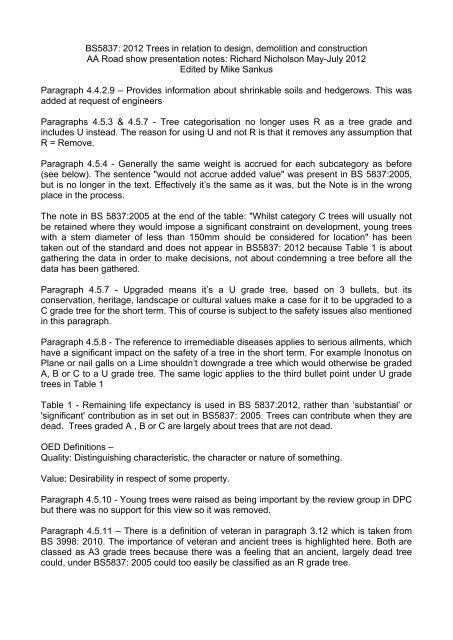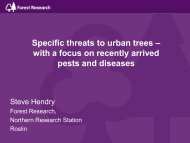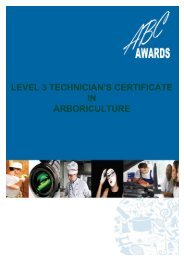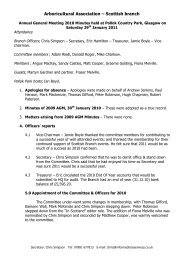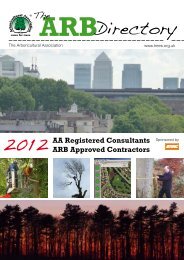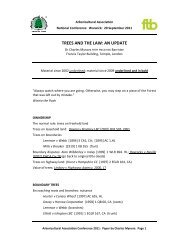BS5837: 2012 Trees in relation to design, demolition - Arboricultural ...
BS5837: 2012 Trees in relation to design, demolition - Arboricultural ...
BS5837: 2012 Trees in relation to design, demolition - Arboricultural ...
Create successful ePaper yourself
Turn your PDF publications into a flip-book with our unique Google optimized e-Paper software.
<strong>BS5837</strong>: <strong>2012</strong> <strong>Trees</strong> <strong>in</strong> <strong>relation</strong> <strong>to</strong> <strong>design</strong>, <strong>demolition</strong> and construction<br />
AA Road show presentation notes: Richard Nicholson May-July <strong>2012</strong><br />
Edited by Mike Sankus<br />
Paragraph 4.4.2.9 – Provides <strong>in</strong>formation about shr<strong>in</strong>kable soils and hedgerows. This was<br />
added at request of eng<strong>in</strong>eers<br />
Paragraphs 4.5.3 & 4.5.7 - Tree categorisation no longer uses R as a tree grade and<br />
<strong>in</strong>cludes U <strong>in</strong>stead. The reason for us<strong>in</strong>g U and not R is that it removes any assumption that<br />
R = Remove.<br />
Paragraph 4.5.4 - Generally the same weight is accrued for each subcategory as before<br />
(see below). The sentence "would not accrue added value" was present <strong>in</strong> BS 5837:2005,<br />
but is no longer <strong>in</strong> the text. Effectively it’s the same as it was, but the Note is <strong>in</strong> the wrong<br />
place <strong>in</strong> the process.<br />
The note <strong>in</strong> BS 5837:2005 at the end of the table: "Whilst category C trees will usually not<br />
be reta<strong>in</strong>ed where they would impose a significant constra<strong>in</strong>t on development, young trees<br />
with a stem diameter of less than 150mm should be considered for location" has been<br />
taken out of the standard and does not appear <strong>in</strong> <strong>BS5837</strong>: <strong>2012</strong> because Table 1 is about<br />
gather<strong>in</strong>g the data <strong>in</strong> order <strong>to</strong> make decisions, not about condemn<strong>in</strong>g a tree before all the<br />
data has been gathered.<br />
Paragraph 4.5.7 - Upgraded means it’s a U grade tree, based on 3 bullets, but its<br />
conservation, heritage, landscape or cultural values make a case for it <strong>to</strong> be upgraded <strong>to</strong> a<br />
C grade tree for the short term. This of course is subject <strong>to</strong> the safety issues also mentioned<br />
<strong>in</strong> this paragraph.<br />
Paragraph 4.5.8 - The reference <strong>to</strong> irremediable diseases applies <strong>to</strong> serious ailments, which<br />
have a significant impact on the safety of a tree <strong>in</strong> the short term. For example Inonotus on<br />
Plane or nail galls on a Lime shouldn’t downgrade a tree which would otherwise be graded<br />
A, B or C <strong>to</strong> a U grade tree. The same logic applies <strong>to</strong> the third bullet po<strong>in</strong>t under U grade<br />
trees <strong>in</strong> Table 1<br />
Table 1 - Rema<strong>in</strong><strong>in</strong>g life expectancy is used <strong>in</strong> BS 5837:<strong>2012</strong>, rather than ‘substantial’ or<br />
'significant' contribution as <strong>in</strong> set out <strong>in</strong> <strong>BS5837</strong>: 2005. <strong>Trees</strong> can contribute when they are<br />
dead. <strong>Trees</strong> graded A , B or C are largely about trees that are not dead.<br />
OED Def<strong>in</strong>itions –<br />
Quality: Dist<strong>in</strong>guish<strong>in</strong>g characteristic, the character or nature of someth<strong>in</strong>g.<br />
Value: Desirability <strong>in</strong> respect of some property.<br />
Paragraph 4.5.10 - Young trees were raised as be<strong>in</strong>g important by the review group <strong>in</strong> DPC<br />
but there was no support for this view so it was removed.<br />
Paragraph 4.5.11 – There is a def<strong>in</strong>ition of veteran <strong>in</strong> paragraph 3.12 which is taken from<br />
BS 3998: 2010. The importance of veteran and ancient trees is highlighted here. Both are<br />
classed as A3 grade trees because there was a feel<strong>in</strong>g that an ancient, largely dead tree<br />
could, under <strong>BS5837</strong>: 2005 could <strong>to</strong>o easily be classified as an R grade tree.


